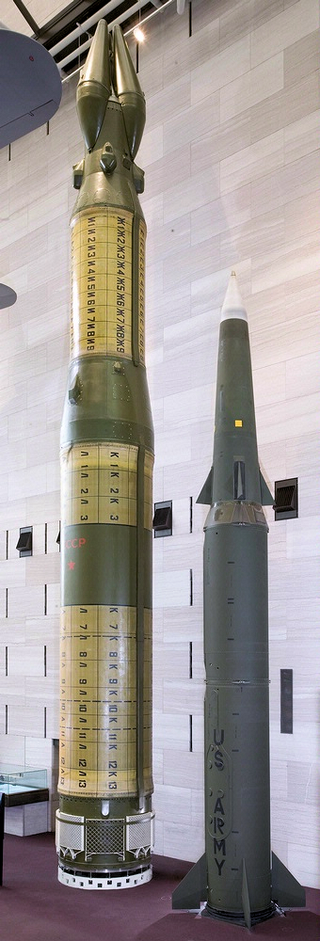On February 1st, the Trump administration announced that the United States will withdraw from the Intermediate-range Nuclear Forces (INF) Treaty with Russia. The next day, Russia responded by doing the same. These withdrawals will take effect in six months, if nothing is done to save the treaty.
This course of events was no surprise, since President Trump has been threatening withdrawal for months, but the lack of surprise makes the decision no more welcome and no less dangerous. Withdrawal from the treaty undermines the security of the United States and its allies, and opens the door to a new era of arms racing, threatening US-Russian nuclear stability.

SS-20 and Pershing II missiles eliminated by the INF Treaty (Source: National Air and Space Museum)
What does the INF Treaty do?
The INF Treaty, signed in 1987 by President Ronald Reagan and Soviet leader Mikhail Gorbachev, eliminated ground-based ballistic and cruise missiles with ranges of 300 to 3,400 miles, whether they carry nuclear or conventional weapons.
The treaty was part of the backbone of the Cold War arms control regime, helping to defuse tension and ratchet down the US-Soviet arms race. It was the first arms control treaty to require the elimination of existing weapons, rather than simply limiting their numbers, and resulted in the destruction of 846 US and 1,846 Soviet missiles. It also established a strong verification process.
Without this treaty, the United States and Russia will both be free to once again develop and deploy such missiles, and both have indicated interest in doing so.
The 2018 National Defense Authorization Act included a requirement to develop a conventional ground-launched cruise missile that would fall into the range prohibited by the INF Treaty, and Congress approved funding such a system in FY 2019. Such efforts, however, are complicated by opposition from NATO states to serving as a base for such missiles.
Withdrawal from the INF Treaty is misguided
Withdrawing from the INF Treaty demonstrates either a lack of understanding of how arms control works on the part of the Trump administration or, worse, a desire to undermine arms control agreements more generally. The latter may be the more likely explanation given the presence of advisors like John Bolton, who has a long history of actively working to oppose such treaties. This attitude is dangerous, and not just because of the demise of a single treaty.
Far from being a drawback, as opponents like Bolton believe, the limits imposed by treaties are one of their main benefits, in addition to providing stability and transparency in cases where they are sorely needed. The Reagan administration did not negotiate the INF Treaty as a favor to the Soviet Union, but rather to improve the security of the United States and its allies.
The proliferation of intermediate-range missiles was a major source of instability in Europe in the early 1980s, when such missiles based in the eastern part of the Soviet Union could deliver nuclear warheads to targets in Western Europe. The United States and NATO moved to deploy their own land-based intermediate-range nuclear missiles to counter this perceived Soviet advantage, adding to the possibility that accidents or miscommunications could quickly lead to a major nuclear conflict. The INF Treaty removed all these missiles.
But isn’t Russia violating the treaty?
For several years, the United States has accused Russia of violating the treaty by developing and beginning to deploy the 9M729 cruise missile. Russia has continually denied the accusations, but there is solid evidence, and the United States should not ignore the violation.
However, the United States benefits from the constraints imposed by the INF Treaty and withdrawal would simply be shooting itself in the foot. Instead, the Trump administration should continue using the mechanisms in place under the treaty to address Russian violations, and undertake additional serious diplomatic efforts to resolve the issue, which it has yet to do.
For its part, Russia has also raised concerns that ground-based launchers designed for use with a US theater missile defense system based in Romania could be used to launch offensive missiles, which would violate the INF treaty as well. The United States has so far refused to discuss these concerns, which has complicated trying to resolve the Russian violations.
No treaty can guarantee that all parties will follow the rules. What they can do is provide clear rules, verification to check compliance with the rules, and mechanisms for addressing issues that arise—including violations. Without such agreements, there are no rules at all.
Broader consequences of withdrawal
If the INF Treaty does indeed end in six months as scheduled, that will leave New START as the only remaining US-Russian treaty constraining nuclear weapons. And even if the administration does not withdraw from New START, it is scheduled to expire in 2021 unless the parties come to an agreement to extend it for up to five years. So far there has been no movement in that direction.
Losing the treaty would not only mean the loss of important limits on US and Russian nuclear weapons, it would also end the expansive verification system that has been developed by the two countries since the 1970s. This means the United States would lose access to valuable information about what Russia is doing and have no standing to raise objections.
With Russia announcing the development of several new nuclear weapons and the United States poised to begin a massive effort to rebuild and enhance its own nuclear arsenal, now is the time to strengthen limits on nuclear arsenals and begin discussions to develop new ones, rather than eliminating them. Cold War leaders learned the hard way that negotiating such limits did more to enhance security on both sides than building ever-larger arsenals.
Instead of repeating past mistakes, the United States should learn from them and take steps now to head off another expensive and dangerous arms race.
